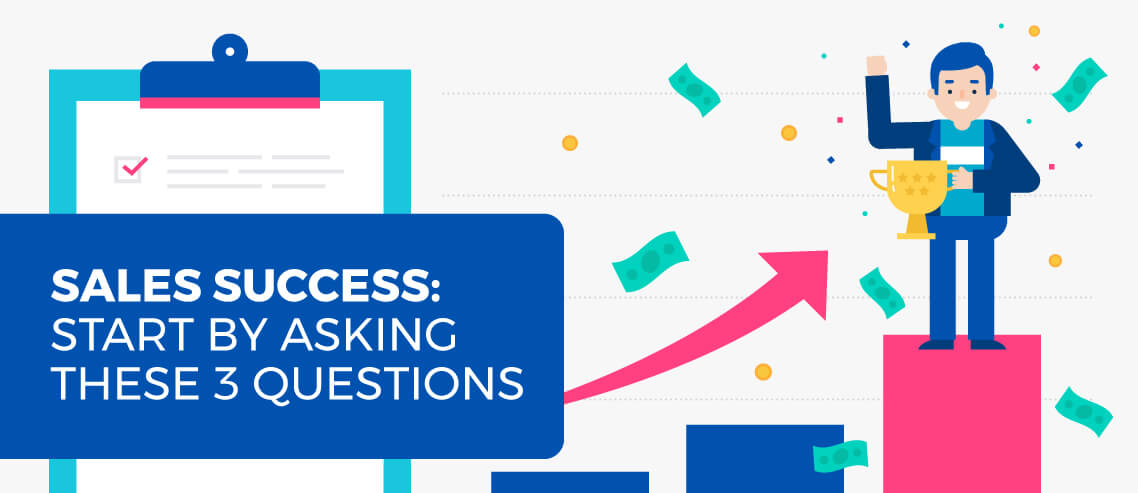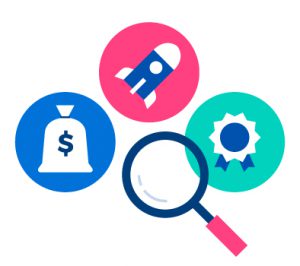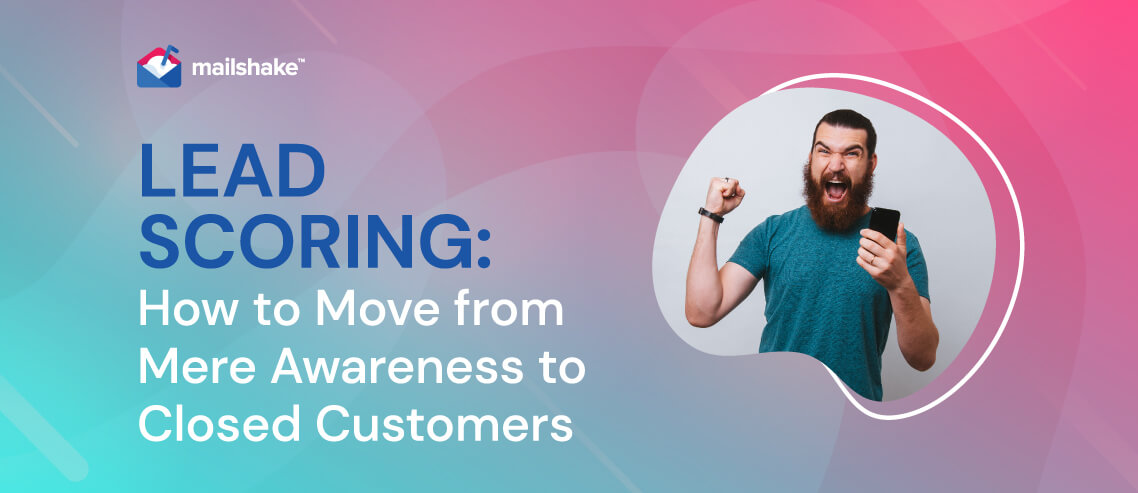Sales Success: Start by Asking These 3 Questions

Contents
Sales success requires an acute understanding of exactly what you’re selling. But I’m not talking about the intricacies of your features and benefits.
No, while you need to understand your product or service, for real sales success, you shouldn’t be thinking about it at all.
You see, you don’t sell your product or your service. You sell an outcome that can only be achieved by the difference between what you’re offering and what the prospect is currently doing. Your product or service is merely a means to this end.
There aren’t many salespeople who realize this, but they’re the ones producing meaningful results for their customers, their companies, and their commission checks.
People wonder why there are so many bad salespeople out there. But from the get-go, sellers are misguided about what they’re supposed to be doing, who they should talk to, and how to talk to them.
RELATED: 4 Sales Skills that Guarantee Your Success (& Put You in the Top 5%)
Those concepts make up the very foundation of selling, and most pros are completely whiffing on them!
Think about it this way: in the terms I’ve already laid out, the overwhelming majority of salespeople do not know what they’re actually selling, so how can they possibly know how to articulate it? And if you can’t articulate it, how can you successfully sell it?
To make matters worse, those same people are out there wasting time arguing about whether cold calling is still alive, or whatever currently trending #hashtag is dominating social media right now.
So much more could be done (and sold) if people took their noses out of the minutiae and just got back to the basics as they relate to sales prospecting concepts. So let’s dig into them here.
Bottom line, for sales success, you need to think differently about what you’re actually selling.
Start by answering three simple questions. The questions are short and simple. The same cannot be said about the answers, and unfortunately, there aren’t enough salespeople who can even answer them.
Keep reading to learn what those questions are and why they’re important.
Why Are You Different?

If you cannot differentiate, you cannot sell.
Read that again.
You must be able to articulate why you are different from, not better than, your biggest competitor, your smallest competitor, and any competitor in between. Better is in the mind and the eye of the beholder, and you are not the beholder in this case.
“Better” is subjective. It’s a value judgment, and a judgment can only be made once a comparison is created. In order for something to be perceived as better, it must first be perceived as different. This is where the conversation starts.
“Different” is objective. Once the difference is articulated, the buyer can think, compare, and subjectively determine if that difference is better for them. Different is inarguable, and when it’s discussed the right way, different is worth paying more for.
Most salespeople cannot articulate why they are different; therefore, most salespeople compete on price.
RELATED: How to Nail a Sales Presentation
You might have a brand-new product or service that has never been offered before, but those situations are very rare. Chances are, you offer something that’s already available to your prospect — either in a prettier package or an upgraded version of what they already have that makes it look new.
In almost every case, there is a defined need for what you provide, and people are already meeting that need somehow. In most cases, they’re already accomplishing the tasks your product or service would help them accomplish.
So, ask yourself, what really makes your solution different? Do you have an answer? Here are some other questions you can answer that will help get you started, and help you learn how to position it.
- Is it a new tool that simplifies an old job?
- Is it a new experience?
- How does it compare to the old experience?
- What task(s) does it eliminate that are tedious?
- What can your prospect accomplish now that they were unable to before?
- Does this concept change the way people think?
- What do they think about differently? Their work? Their personal lives?
- Is there a cultural impact? Is that impact work-related? Is it societal?
There are more questions along these lines to be answered, but if you work on these, you’ll be on the right track.
Once you start to understand why you and your solution are different, you can begin to make the case that you and your solution are valuable.
Why Are You Valuable?

Once you’ve articulated your differentiators, you need be able to express what those differentiators mean.
Differences and value are almost analogous to features and benefits. While they are not the same, they go hand-in-hand. Your features and benefits are worth talking about only in terms of why they’re different and why they’re valuable.
Note: By taking this approach, you immediately ramp up your odds of success in sales. Remember, features only matter if they add value to the user.
So ask yourself…
What is your new tool or toy going to do for your customer?
- Is it going to make them more profitable? How?
- Is it going to save them time?
- Is it going to save them money?
- Is it going to increase their cost while increasing their revenues at a higher rate?
- Is it going to increase their productivity in such a way that they can do more in less time? With less people?
Does your solution make work fun, which can not only increase productivity, but morale as well? If your solution makes the workplace a more enjoyable place to be every day…
- Does that increase attendance? Engagement?
- Does that attract the best talent?
- Does the best talent drive the best results?
I can go down these wormholes all day long, and I think you see what I’m getting at here. What is the result of your difference? And why is that something your customer would want to have happen?
You can see the benefits and value are very closely related. Benefits are objective, and the value of those benefits is subjective, so the objective-subjective dynamic is in play once again.
Still, creating the perception of value is not enough. For real sales success, you need to take it a step further and create a desire for that perceived value.
Why Does It Matter?

If you created a compelling case for why your solution is valuable, you still have not created a compelling case for why that value is worth anything. In order to do that, you really need to understand your buyer’s motives.
What is the buyer trying to accomplish? What’s on the other side of that accomplishment? This is where the rubber meets the road. The secret weapon for sales success is understanding why people buy.
RELATED: Relationship Selling: Definition, Techniques, and Examples
This may come as a surprise, but it’s not always about the money. Not every business is focused on increasing profit. More specifically, not every business is focused on increasing their profit the way you’re telling them they will when they work with you.
Yes, I know you’re special, but you are not the only one selling to them like this. You have to go further than that. If it is about money, you need to understand how much they want to save, and what they want to do with those savings.
Most importantly, you must understand what their overall goal is for their business.
- Is it really about maximizing profit?
- Is there another cause that’s important to them that is tied to their “why”?
- Do they feel responsible for creating outcomes other than value for their shareholders?
- Is there another outcome worthwhile enough that they’d be willing to take even a small financial loss?
These situations are much more common than you may think. Take your financial blinders off and connect with the purpose of the customer’s business.
Help them identify an outcome that will help them achieve their goals, then paint the picture of them achieving that goal — with your solution as the centerpiece. This is key to succeeding in sales.
But there’s an issue…
Be aware, you’re asking someone to stop doing something the way they normally do it, make a change, and accept any learning curves, risks, and potential consequences along the way. That’s a big ask when you think about it, right?
Even a small change can have a big impact on outcomes. Ideally, that change will be tremendously beneficial, and you’ll be the hero in the customer’s eyes. However, there is always at least a possibility that the opposite will happen.
Your job as the salesperson is to create an upside — as certain an upside as possible — that’s so great and impactful, the risk of a negative outcome is more than worth the attempt. Your prospect is asking, “Why should I change the way I do business for you?” You’d better have a good answer.
When you have a good grasp of why you’re different, why you’re valuable, and why the outcome matters, you can start to relate to your prospects in ways that nobody else can. This is vital in today’s marketplace where the only tangible differentiator at first glance is the price, and winning business by winning the price war doesn’t feel like much of a win at all.
One Final Tip for Sales Success
Put yourself in your prospect’s shoes and listen to what you’re saying. Try to remove your biases and consider theirs.
- Why should they keep talking to you?
- Would you buy what you’re selling?
- Are you presenting unique advantages or just pitching another product?
Time and attention are invaluable, you will not be able to waste them twice.





